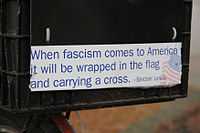Bumper sticker


A bumper sticker is an adhesive label or sticker with a message, intended to be attached to the bumper of an automobile and to be read by the occupants of other vehicles—although they are often stuck onto other objects. Most bumper stickers are about 30 cm by 8 cm (12 in by 3 in) and are often made of PVC.
Purpose

Bumper stickers can be commercial, religious, secular, humorous, or in support of a sports team or other organization. They may promote or oppose a particular philosophical or political position. In some countries, such as the United States, bumper stickers are a popular way of showing support for a candidate for a government seat and become more common during election years. In others, such as the United Kingdom, they are rarely seen in any form.
One variety of bumper sticker is the country tag. This is typically used for cars crossing international borders, and is overseen by the United Nations as the Distinguishing Signs of Vehicles in International Traffic, being authorized by the UN's Geneva Convention on Road Traffic (1949) and Vienna Convention on Road Traffic (1968). Often the country code is displayed on the license plate itself.
These have (usually in the United States) been spun off into tags indicating a country with which the driver affiliates, or more humorously to indicate things like a region (OBX), political party (GOP), support for rabbit rescue groups (BUN), etc.
People who opt to exhibit their individuality through these decals may take part in more acts of road rage. Colorado State University social psychologist, William Szlemko, found that aggressive driving is linked to the number of markers a person has on his/her car, regardless of the messages portrayed.[1]
Application and removal
Due to the movement of the vehicle and changing weather conditions, the sticker needs to adhere well to the bumper surface. However, there are some "easy to remove" bumper stickers and magnetic bumper stickers. Bumper stickers can be removed with penetrating oil or a heat gun. Home remedies also include using common household items, such as WD-40 or paint thinner.
History
Stickers have long been used to convey messages, including political and informational messages, on various surfaces that they might be placed. The introduction of stickers made specifically for the purpose of placement on vehicle bumpers necessarily date roughly with the introduction of the automobile bumper; the Ford Model T lacked bumpers to which bumper stickers could be conveniently attached, but the Ford Model A, introduced in 1927, had them.[2] One online source[3] credits the current bumper sticker to Forest P. Gill, a silkscreen printer from Kansas City.[4]
The first bumper stickers appeared shortly before World War II; they were flag-like, and attached to the bumper by wires. Gill replaced the wire attachments with pressure-sensitive adhesive, and as a result bumper stickers became more widespread and practical.
The first widespread use of the advertising bumper sticker might have been the ubiquitous "See Rock City" signs, touting a tourist attraction atop Lookout Mountain, Tennessee. In the 1940s, visitors to the site had a sticker applied to their car, which duplicated the famous signs painted on the roofs of barns throughout the southeastern USA. Rock City staff would circulate through the parking lot, applying the promotional sticker to every car. Although called "stickers", these bumper signs were really lightweight, screen-printed cardboard. They were attached by means of thin aluminum strips, running through the end of the sign and wrapping around the bumper.
Around the world
Considerable variation exists around the world as to the context and purpose of stickers.
On some vehicles, some stickers are like trophy signs of WWII aeroplanes, either of locations visited or actions completed.
They have also been extensively applied to rear windows as well, where legislative measures have not banned such use. For instance in Sweden that is the normal place to put them and the bumper sticker is actually called "bakrutedekal" (rear window decal).
More recently, bumper stickers have become a route for advertising and a few companies offer to match car owners to advertisers willing to pay for the ad.
In Israel, one of the most popular songs of all time is "Shirat Hasticker" ("The Sticker Song") by Hadag Nachash, a song composed entirely of bumper sticker slogans.
Variants of the bumper sticker have developed in recent years, including vinyl decals meant to be applied to a car's rear windshield, and chrome emblems to be affixed to the body of the car itself, generally on the rear (the "Jesus fish" and its "Darwin fish" counterpart are popular examples).
Gallery
-
Bumper sticker supporting the 1976 Gerald Ford presidential campaign.
-

Bumper sticker with a Sinclair Lewis quote on a bicycle
-

The ichthys fish symbol, which represents Christianity, and its parodies are popular bumper sticker themes.
See also
- Bumper (automobile)
- Car
- Sticker
- Country tag
References
- ↑ Vedantam, Shankar (2008-06-17). "Sign of road rage may be on bumper". Chicago Tribune. Retrieved 2008-06-17.
- ↑ Samuelson, Robert. "Bumper Sticker Politics". The Daily Beast. Newsweek. Retrieved 4 September 2012.
- ↑ http://www.bumprstickrz.com/bumperstickerhistory.html[]
- ↑ http://www.kansascity.com/238/story/581859-p2.html[]
Further reading
- Salamon, Hagar (2005-01-01). "Hacam in the turbulent discursive sphere of Israeli bumper stickers". Hebrew Studies Journal.
External links
| Wikimedia Commons has media related to Bumper stickers. |
| ||||||||||||||||||||||||||||||||||||||||||||||||||
